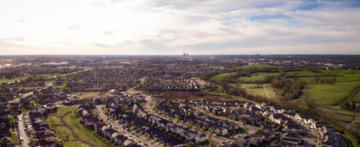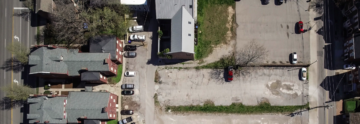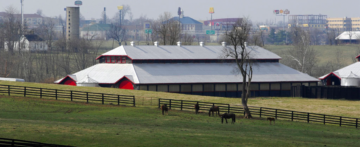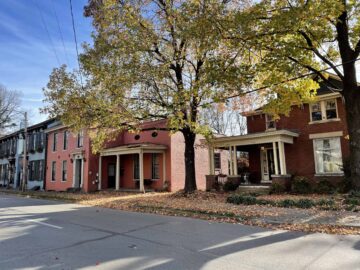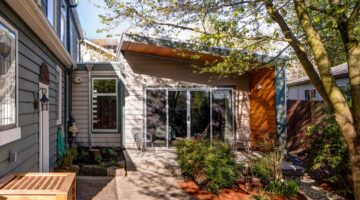10 FAQs About the Lexington Urban Service Boundary
The Lexington Urban Service Boundary, although frequently debated, is often misunderstood. It’s part of our mission to educate the community about how and why smart growth improves the quality of life for all residents. Here are 10 frequently asked questions about the Lexington Urban Service Boundary.
1. What is the Urban Service Boundary?
First implemented in 1958, the Urban Service Boundary (USB) is a geographic demarcation that distinguishes Lexington-Fayette County’s bustling urban core from the lush agricultural space around it. It’s also the extent to which the county government provides public services, such as trash pick-up and the sewer system. Think of the USB as a proactive method of ensuring our city makes smart decisions about how to manage land responsibly. It focuses on making the most of the space we have so that we don’t expand unnecessarily.
2. Why do we have it?
The USB is unique because it protects both the quality of our booming city and the surrounding farmland that makes Lexington such a special place. The USB encourages city planners and developers to design with efficiency and sustainability in mind and keeps the cost of our city infrastructure in check. Likewise, the USB preserves our beautiful and productive agricultural land, responsible annually for $2.3 billion dollars of economic activity and 1 in 12 direct jobs in Lexington alone. We also support the USB because Kentuckians, by tradition, are resourceful people. We value our land, and we believe we should be good stewards of it and do the absolute best we can with what we have before seeking more.
3. How does the USB support efficient and sustainable growth?
The USB prioritizes infill redevelopment, which improves upon neglected and often vacant areas within the boundary. Infill redevelopment makes good use of the available spaces we already have instead of haphazardly extending the boundary, which can lead to urban sprawl and unsustainable stress on our infrastructure. When cities grow outward instead of upward, the need for more infrastructure like roadways and sewer systems significantly increases the cost for taxpayers and degrades the environment. A recent study performed by a local, nationally-respected planning firm, Lord Aeck Sargent, revealed over 17,000 acres of land suitable for potential development and redevelopment within the USB. They also recently completed the Grow Smart Study that Fayette Alliance funded, which shows where and how we can build more walkable, affordable neighborhoods on those acres.
4. What is urban sprawl, and why is it something we want to avoid?
Urban sprawl is the unmitigated expansion of a city, often characterized by generic housing communities and single-use zoning. If infill redevelopment seeks to build cities upward, sprawl spirals outward, often without consideration for the holistic wellbeing of a city and its inhabitants. Studies have shown that urban sprawl degrades the habitat, pollutes the environment, and propagates racial and social inequality. Sprawl also increases the cost of infrastructure, because far-reaching and outspread communities require more roads and more utilities, and these costs fall on the taxpayers.
5. Are there other cities in the US with Urban Service Boundaries?
Sometimes referred to as an “Urban Growth Boundary,” several cities in the US have implemented similar strategies to prevent the detrimental consequences of urban sprawl, like Boulder, Seattle, Knoxville, San Jose, and Honolulu. In fact, the states of Oregon, Washington, and Tennessee require all their cities to establish urban growth boundaries. Similar boundaries have also been implemented in major cities around the world, like Melbourne, Toronto, and London. Lexington’s USB, like the growth boundaries of some of the world’s largest and most successful cities, isn’t a reaction to growth. Instead, it’s a proactive choice to support healthy, sustainable growth in the future.
6. Does the USB affect housing prices in Fayette County?
Housing prices are a result of supply and demand. Everyone knows this: when the demand exceeds the supply, prices increase. Some may claim the USB is to blame for rising home costs, but the majority of US cities with the worst housing shortages have no growth boundaries. In fact, the top two cities suffering severe housing shortages (Dallas and Austin) are among the most sprawling cities in the US. The Lexington Bluegrass Association of Realtors (LBAR) funded an impartial study at the University of Kentucky in 2017, and the study concluded that Lexington is actually experiencing a lesser surge of home prices than the national average and that expanding the USB would not have a long term impact on housing prices, if any at all.
7. What if my biggest concern is how the Urban Service Boundary affects the environment?
The Urban Service Boundary is unequivocally better for the environment than sprawling low-density clusters. Our county’s agricultural landscape provides a habitat for a remarkable assortment of wildlife. Urban sprawl fragments these habitats and disrupts entire ecosystems, which sometimes never recover. Sprawling communities also increase reliance on private automobiles, which means more paved surfaces and more air pollution. The USB, as a smart design approach to city planning, preserves the surrounding environment.
8. Why protect rural land in Fayette County, anyway?
When people say that Lexington is a special place, it’s not just rhetoric. Land in central Kentucky, especially in Fayette County, has incredible agricultural potential because of how limestone has enhanced the soil, a process that began in prehistoric times and has infused the soil with calcium and other minerals. The agricultural endeavors that rely on Lexington’s unique, rich soil have endured for generations precisely because of where they are. Encroaching upon our protected land not only threatens these traditions but doing so jeopardizes our identity on the national and even the global stage. Plus, our rural land is the factory floor of the productive agriculture industry that fuels our economy in Fayette County, accounting for 1 in 12 jobs, a $2.3B annual economic impact, and $8.5M in tax revenue for our city.
9. What motivations are there for expanding the Urban Service Boundary?
You may have noticed there are fewer and fewer new homes built in Lexington at prices catering to first-time buyers. There are, however, several homes currently under construction for prices starting around $400,000. Some of the newer homes being built tout prices closer to $700,000, far beyond the budget of Lexington’s middle-class residents. Some within the building and development community argue that the USB should be expanded because infill redevelopment is difficult and expensive, and “greenfield” development is easier. No research shows, however, that more attainable housing will be built, more Affordable housing will be built, or that housing prices will go down if we do so. Some established neighborhood folks stoke “not in my backyard” sentiments by opposing solutions like Accessory Dwelling Units, which are strongly supported by city planning professionals in Lexington and around the country as one way (among many others) to increase housing types, and decrease housing costs, for all of our community members. These sentiments can make it seem like expanding the Urban Service Boundary is the only way to meet our needs. Research and history, however, tell us differently. According to a 2016 LFUCG study, 72% of the community was against expanding the Urban Service Boundary.
10. Why should we make room for growth, anyway?
Lexington is growing, whether we like it or not, and that’s not a bad thing. People are attracted to cities that are unique and culturally significant. People also want to live in smartly designed cities, where civic leaders are devoted to improving upon our infrastructure. Fayette Alliance is committed to city growth that is sustainable, scalable, and environmentally responsible. The question isn’t if we grow, it’s how.


